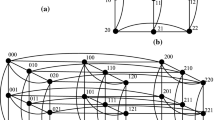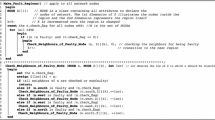Abstract
The three-dimensional (3D) processor array has benefits of reducing interconnection latency, consuming less power and improving bandwidths compared to 2D processor arrays. However, it suffers from frequent faults due to power overheating during massively parallel computing. To achieve fault-tolerance under such a such a scenario, an effective method is to construct a non-faulty sub-array from the faulty array as large as possible, such that the original application can still work on the sub-array. However, logical sub-arrays produced by previous works contain large number of long interconnects, which leads to more communication cost, capacitance and dynamic power dissipation. In this paper,we investigate the problem of reducing the interconnection length of a logical array. First, we prove that it is a NP-hard problem. Then we propose an efficient heuristic to reduce the interconnection redundancy of a logical array by reducing the number of long interconnects in each logical plane. Each logical plane is optimized based on statistical information. Experimental results show that, on 32×32×32 host array with fault densities ranging from 0.1% to 5%, the proposed algorithm is capable of reducing the interconnection length by 49.7% and 29.8% in average compared to the existing algorithm GPR and CAR, respectively.
Access this chapter
Tax calculation will be finalised at checkout
Purchases are for personal use only
Preview
Unable to display preview. Download preview PDF.
Similar content being viewed by others
References
Koren, I., Koren, Z.: Defect tolerance in VLSI circuits: Techniques and yield analysis. Proceedings of the IEEE 86(9), 1819–1838 (1998)
Koren, I.: On the design and analysis of fault tolerant NoC architecture using spare routers. In: Proc. IEEE Int. Symp. on Quality Electronic Design, pp. 115–120 (2000)
Tan, P.J., Le, T., Mantri, P., Westfall, J.: Testing of UltraSPARC T1 Microprocessor and its Challenges n. In: Proc. IEEE Int. Test Conf, pp. 1–10 (2006)
Makar, S., Altinis, T., Patkar, N., Wu, J.: Testing of Vega2, a chip multi-processor with spare processors. In: Proc. IEEE Int. Test Conf, pp. 1–10 (2007)
Schuchman, E., Vijaykumar, T.: Rescue: A microarchitecture for testability and defect tolerance. In: Proc. Int. Symp. on Computer Architecture, pp. 160–171 (2005)
Ajwani, D., Ali, S., Morrison, J.: Graph Partitioning for Reconfigurable Topology. In: IEEE Int. Parallel & Distributed Processing Symp., Shanghai, China, pp. 836–847 (2012)
Modarressi, M., Sarbazi-Azad, H., Tavakkol, A.: An efficient dynamically reconfigurable on-chip network architecture. In: Proc. Design Automation Conference, pp. 310–313 (2010)
Modarressi, M., Tavakkol, A., Sarbazi-Azad, H.: Application-Aware Topology Reconfiguration for On-Chip Networks. IEEE Trans. on VLSI Systems 19(11), 2010–2022 (2011)
Modarressi, M., Sarbazi-Azad, H.: Power-aware mapping for reconfigurable NoC architectures. In: Proc. of the 25th International Conference on Computer Design, pp. 417–422 (2007)
Takanami, I., Horita, T.: A Built-in Circuit for Self-Repairing Mesh-Connected Processor Arrays by Direct Spare Replacement. In: IEEE Pacific Rim Int. Symp. on Dependable Computing (PRDC), Niigata, pp. 96–104 (2012)
Lin, S.Y., Shen, W.C., Hsu, C.C., Fault-tolerant, A.Y.W.: Router with built-in self-test/self-diagnosis and fault-isolation circuits for 2D-mesh based chip multiprocessor systems. Jour. of Electrical Engineering 16(3), 213–222 (2009)
Low, C.P.: An efficient reconfiguration algorithm for degradable VLSI/WSI arrays. IEEE Transactions on Computers 49(6), 553–559 (2000)
Wu, J., Thambipillai, S., Jiang, G., Wang, K.: Constructing Sub-Arrays with Short Interconnects from Degradable VLSI Arrays. IEEE Transactions on parallel and Distributed System 25(4), 929–938 (2014)
Wu Jigang, T., Srikanthan, X., Han, X.: Preprocessing and Partial Rerouting Techniques for Accelerating Reconfiguration of Degradable VLSI Arrays. IEEE Transactions on Very Large Scale Intergration (VLSI) Systems 18(2), 315–319 (2010)
Fukushi, M., Fukushima, Y., Horiguchi, S.: A genetic approach for the reconfiguration of degradable processor arrays. In: Proc. of 20th IEEE International Symposium on Defect Fault Tolerance VLSI System, pp. 63–71 (2005)
Takanami, I., Horita, T.: A Built-in Self-Reconfigurable Scheme for 3D Mesh Arrays. In: International Symposium on Parallel Architectures, Algorithms, and Networks (I-SPAN 1997), pp. 458–464 (1997)
Horiguchi, S., Numata, I.: Self-Reconfiguration Scheme of 3D-Mesh Arrays. In: Proc. of IEEE International Symposium on Defect and Fault Tolerance in VLSI Systems, pp. 276–281 (1998)
Jiang, G., Wu, J., Sun, J.: Efficient Reconfiguration Algorithms for Communication-Aware Three-dimensional Processor Arrays. Parallel Computing 39(9), 490–504 (2013)
Fukushi, M., Horiguchi, S.: A Self-reconfigurable Hardware Architecture for Mesh Arrays Using Single/double Vertical Track Switches. IEEE Trans. on Instrumentation and Measurement 53(2), 357–367 (2004)
Author information
Authors and Affiliations
Editor information
Editors and Affiliations
Rights and permissions
Copyright information
© 2014 Springer International Publishing Switzerland
About this paper
Cite this paper
Jiang, G., Wu, J., Sun, J., Zhu, L. (2014). Reducing the Interconnection Length for 3D Fault-Tolerant Processor Arrays. In: Sun, Xh., et al. Algorithms and Architectures for Parallel Processing. ICA3PP 2014. Lecture Notes in Computer Science, vol 8630. Springer, Cham. https://doi.org/10.1007/978-3-319-11197-1_38
Download citation
DOI: https://doi.org/10.1007/978-3-319-11197-1_38
Publisher Name: Springer, Cham
Print ISBN: 978-3-319-11196-4
Online ISBN: 978-3-319-11197-1
eBook Packages: Computer ScienceComputer Science (R0)




